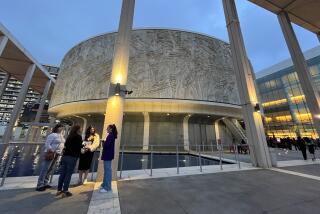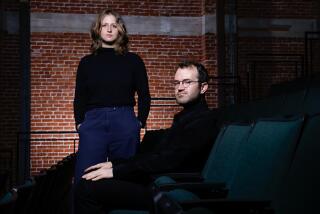Hollywood Fringe Festival, a theater party with room to grow
On a crowded sidewalk outside of Theatre Asylum last weekend, Edna Garrett from “The Facts of Life” was virtually blocking traffic with her huge wig. Nearby, Lurch from “The Addams Family” was darting through the throng to greet a friend, his twinkling eyes and widening smile softening the effect of his cadaverous makeup.
Yes, it’s that whimsical time of year again: the fourth annual Hollywood Fringe Festival has swung into action. The actors impersonating these famous TV characters had just finished a performance of “The Real Housekeepers of Studio City,” and Joe Greene, who not only plays Edna in elaborate drag but wrote the music for this bite-size musical candy bar, was asking a well-wisher whether she had fun.
At the informal Hollywood Fringe Festival, the distance between the artists and the audience is negligible. It’s not just the postage-stamp size of the venues that creates intimacy. It’s that so many in attendance have friends onstage or are involved in their own fringe exploits. This is a theater party for theater people (amateur and professional alike) and the friends and fans who support them, a great many of whom look like they wouldn’t mind taking a turn in the spotlight themselves.
PHOTOS: Hollywood Fringe Festival, a theater party
With 25,000 tickets sold in 2012 and expectations of selling more than 35,000 this year, this madcap Hollywood shindig is growing only stronger. The festival, which runs through June 30, includes more than 1,000 performances of more than 200 offerings spread out at 20 venues throughout central Hollywood.
One revitalizing fact: The age demographic of fringe theatergoers is decidedly lower than that of the blue-rinse set that keeps our larger institutional theaters afloat with their blessedly loyal patronage.
The HFF is clearly a civic boon to Los Angeles. The communal energy is infectious. The economic upside for local businesses is a political selling point. And throughout much of June the city’s sprawling geography suddenly seems manageable — a hub is born along Hollywood’s Theatre Row.
Does it matter if much of the work is trifling?
This is a question, not an evaluation of this year’s offerings. Extrapolating from the handful of shows I’ve seen would be silly. And it must be said that searching for gold at any fringe festival in the world, including the all-mighty Edinburgh Festival Fringe or North America’s grandee, the New York International Fringe Festival (FringeNYC), is a game in which the pursuit is the real thrill.
A fringe festival is a showcase (a more cynical type might say marketing tool) in which self-produced work of a scattershot nature — from wacky solo performances to embryonic musicals — can be introduced in a low-cost way to an adventurous audience and perhaps even an influential critic or two. Publicity rather than box-office lucre is the chief reward.
PHOTOS: Arts and culture in pictures by The Times
Fringe festival habitués aren’t packing in five shows a day to see next year’s Tony Award winner for best play. Driving them on is the love of live performance, with its jaunty irreverence and allergy to mass-market conformity. Fringe-goers are like beachcombers with a metal detector, happy to come upon a curiously shaped solitary earring. Word of mouth, disseminated easily through online chatter and citizen reviews, guides their wanderings.
But how does the Hollywood Fringe Festival fit into a city that already has a year-round fringe scene courtesy of Los Angeles’ 99-Seat-Plan, the Actors’ Equity agreement allowing theaters “to utilize the work and talent of Equity members without wage compensation”?
At an outdoor table at Fringe Central Station, the festival’s meeting point and watering hole, I asked two of the HFF’s founders, Ben Hill, the festival director, and his wife, Stacy Jones Hill, the communications director, about the decision to make this an open or noncurated festival. Was this the right choice for a city already challenged by the varying quality of so much theatrical activity?
Hill, who previously founded the Hatchery Festival in Washington, D.C., a showcase of new plays from rising talents, knew he needed help in figuring out the dimensions of a fringe festival in Los Angeles. Having moved to L.A. from Iowa City in only 2007, he sought expert advice on a town that doesn’t easily disclose its secrets to outsiders.
Ezra Buzzington, who had a hand in the birth of the curated FringeNYC, is one of several consultants who advised Hill to go in a noncurated direction, arguing (for reasons Hill never made entirely clear in our interview) that a curated fringe in L.A. would be harder to pull off. (“Most fringes are non-curated,” Jones Hill elaborated in a follow-up email, though some operate on a lottery model versus ‘come-one-come-all,’” the HFF’s model.)
The HFF stands behind its decision to make this an open festival even if the rationale remains somewhat mysterious. L.A. theater could use a fringe with a filter — anything to separate the wheat from the chaff would be invaluable. But an open fringe is better than no fringe at all.
Noncurated, it should be said, doesn’t mean flying by the seat of your pants. The festival is highly organized (https://www.hollywoodfringe.org is a user-friendly marvel). And there are steps that weed out the halfhearted. Artists have to create an online profile and secure a venue. They’re also encouraged to take part in workshops that help them become better producers of their own work.
PHOTOS: Hollywood stars on stage
The openness of the festival, Hill said, has become a “constitutional ethic,” forcing his associates and him to wear “quality blinders,” so that they can treat “all their participants equally.” Behind this is a desire for diversity and experiment, but it also suggests a superhuman tolerance for semi-professionalism.
Yet there’s no arguing with success. Ticket sales have grown “at a rate of 25% during the first three years,” said Jones Hill. Hill touted HFF’s international name recognition, a precious feat given that the festival began in only 2010. The “Hollywood” in the title certainly offers a branding boost, something they hope to further capitalize on as the festival moves out of its toddler phase.
Still, Hill acknowledged that the festival hasn’t spawned a “Urinetown,” the musical satire that emerged from FringeNYC and eventually made its way to Broadway. Jones Hill said that the festival has presented work that has been subsequently produced elsewhere and published, but when asked if the range of participants tilted heavily (even by fringe standards) toward early-career artists, the two offered only vague qualifications.
The Edinburgh Festival Fringe, also noncurated, was an inspirational model for HFF. But it’s significantly larger, much more established and a focal point of global media outlets, which descend on the Scottish city to cover the multitude of world-class arts festivals taking place simultaneously. Mature and entry-level theater practitioners are drawn to the Edinburgh Festival Fringe for its pedigree and spotlight. The HFF doesn’t have the same pull.
All it takes is one breakout hit for the prestige factor to rise and with it the quality of the next year’s participants. Such a galvanizing winner is unlikely to emerge from the amiable group of shows I caught last weekend — “Experiment,” “# Hashtag,” “The Devil and Billy Markham,” and “The Real Housekeepers of Studio City.”
PHOTOS: Hollywood Fringe Festival, a theater party
All of these works were performed with admirable commitment, but I couldn’t help thinking of the opportunity cost of my Fringe theatergoing — the L.A. productions I wasn’t getting to see on those evenings, such as the Echo Theater Company’s “Bob” or the Fountain Theatre’s “Heart Song.”
If a theater buff looking to binge on plays and musicals this weekend asked for my guidance, I’d point them in the direction of “Dying City” at Rogue Machine, “We are Proud to Present a Presentation…” at the Matrix Theatre, “Neva” at South Coast Repertory and “Alcestis” (just starting previews) at the Theatre @ Boston Court.
This work won’t be to everyone’s taste, but it’s serious and substantial — qualities that aren’t a top priority in the fringe marketplace, in which attention-grabbing titles (“Exorcistic: The Rock Musical Parody Experiment,” “If You’re Watching This, I’m Dead”) do the work of a carnival barker.
Several L.A. theater artists I spoke to told me that they had no opinion of the HFF because they had been basically ignoring it. Regular theatergoers, they had yet to be enticed by the work on tap. But others spoke glowingly of the fringe’s value to L.A.’s theater ecology.
One such yea-sayer, USC School of Dramatic Arts Dean Madeline Puzo, praised the festival for encouraging “theater artists to take authority and responsibility for mounting their own work rather than waiting for the next job or producer.” She also approves of the way its concentration of offerings “draws attention to the energetic and diverse theater scene that Los Angeles supports.”
Another advocate for the HFF is theater artist Luis Alfaro, who conveyed in an email his belief that the fringe is”essential for building a movement in Los Angeles for quality home-based work that allows for experimentation.”
I agree with both of them, but as a critic, I want to see the best plays and musicals possible. How can the HFF’s offerings grow in quality?
I put the question to Matthew Quinn, a partner with the producing group Combined Artform and owner and manager of Theatre Asylum, a busy HFF venue. He is also a producer of fringe shows as well as an executive producer of the Best of Hollywood Fringe Extensions in July, a program outside of the HFF that allows the cream of the festival crop to have an extended life at Theatre Asylum and other participating Hollywood venues. Quinn said that the festival has already “exceeded all expectations.” The one area that he thought could be improved upon was the presence of international performers.
Any outreach the HFF presenters could do to increase the artistic level short of betraying their vision of an open festival should be undertaken. The Hollywood Fringe Festival is too big to ignore. But for the work to truly boost L.A.’s standing as a theater town, the art should be doing more of the talking.
More to Read
The biggest entertainment stories
Get our big stories about Hollywood, film, television, music, arts, culture and more right in your inbox as soon as they publish.
You may occasionally receive promotional content from the Los Angeles Times.







